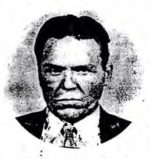 Front Page Detective, March 1940. On March 9, 1935, Chief Deputy Sheriff Roy Emery of the Hot Springs Sheriff Department in Garland County, Arkansas, received a call informing him that the body of Tom Menser had been found in Menser’s cabin in Mazam Township, Arkansas. Sheriff Emery and Sheriff Will Lowe went to Mazam Township to investigate the scene of the crime. Emery and Lowe interviewed several mountaineers living in the area of Tom Menser’s cabin. During the interviews, some of these mountaineers stated that they recalled seeing bright lights shooting toward the sky on the evening of the murder. Based on this information, Emery and Lowe questioned locals about anyone who owned a powerful flashlight. During the investigation regarding the flashlight, the sheriffs learned that Roy House, a young man in the community, grew up visiting Menser. They went to the House’s home and questioned Roy House’s mother about her son. They then learned that Roy House owned a flashlight and that he had left town. In investigating Roy House further, Emery and Lowe discovered that he had been hanging out and drinking with Ayliff Draper prior to leaving town. Draper lived in Perryville, Arkansas, approximately sixty miles from Mazam Township. Emery and Lowe went to Perryville to interview Draper, and Draper was later brought to Hot Springs, Arkansas, for further questioning. During the questioning, Draper told the officers that he was with Roy House the night of the murder. Draper also told them that House had talked to him about robbing Tom Menser, but that Draper had told House that he didn’t want anything to do with the robbery. Draper told the two sheriffs that House had gotten out of Draper’s truck near Menser’s cabin on the night of the murder, and that he had not seen House since then. Soon after Draper was questioned in Hot Springs, the District Attorney sought to indict Draper and House for murder in the first degree. The grand jury returned the indictment and Draper was put in jail. While Draper was held in jail awaiting trial, Chief Deputy Sheriff Emery and Deputy Sheriff Lowe continued to try to locate Roy House. On August 21, 1935, House was picked up in Amarillo, Texas, on separate charges. Emery and Lowe went to Amarillo to escort House back to Arkansas. During the trip from Amarillo, Texas, to Hot Springs, Arkansas, House told Emery and Lowe that it was Ayliff Draper’s idea to rob Menser and that Draper had killed Menser during the robbery. At both his own trial and the trial of Ayliff Draper, Roy House maintained this story and testified that Ayliff Draper had killed Tom Menser. In late 1935, Roy House and Ayliff Draper were both found guilty of murder in the first degree and sentenced to death. An execution date of January 24, 1936 was set, and the two men were held at Tucker Prison Farm at Pine Bluff. On March 6, 1936, Draper filed an appeal with the Arkansas Supreme Court on the grounds that the jury instructions provided at his trial were erroneous. The Arkansas Supreme Court found no error and affirmed the Circuit Court’s judgment. The executions of House and Draper were postponed several times in 1936 pending appeals, and the Arkansas Supreme Court set a final execution date of September 25, 1936. During the appeal process, Emery and Lowe continued to investigate the case and attempted to obtain a confession from Roy House. The sheriffs’ efforts paid off on September l0, 1936, just fifteen days before the scheduled execution of Ayliff Draper, when Roy House confessed that he had killed Tom Menser by himself and that Ayliff Draper was not involved. The Governor was called regarding Roy House’s confession and he issued a thirty-day stay of execution for Ayliff Draper. On September 11, 1936, Roy House was taken back to the Menser’s cabin so that he could explain to the officers what happened on the day of the murder. House also showed the officers where he threw the tire tool that he had used to strike and kill Menser. On September 21, 1936, Governor J. M. Futrell commuted Ayliff Draper’s death sentence to life in prison. It wasn’t until August 19, 1938 that Governor Carl E. Bailey pardoned Ayliff Draper. Draper was finally released from prison in September 1936, nearly two years after Roy House’s last minute confession exonerated him of the murder of Tom Menser. The following month, at the age of 22, Roy House was executed by the State of Arkansas. - Researched by Kimberleigh Criswell
|